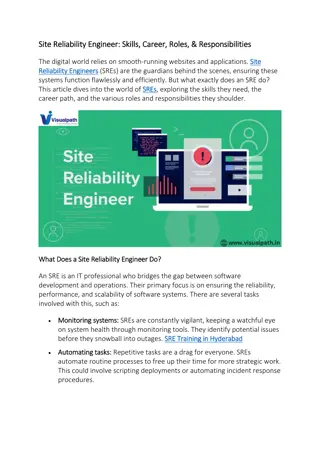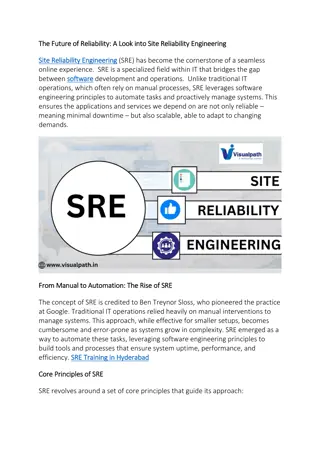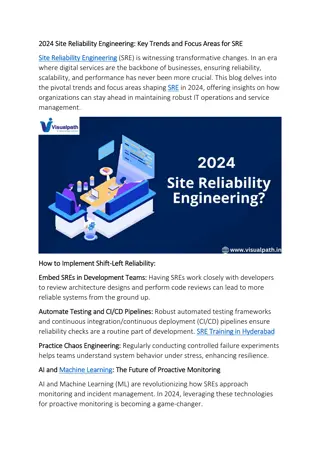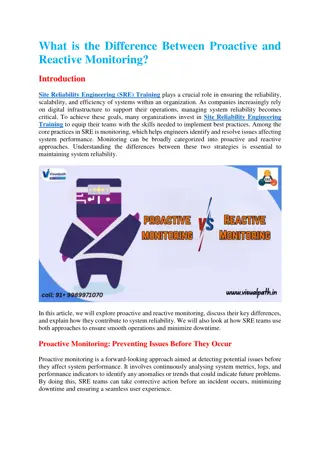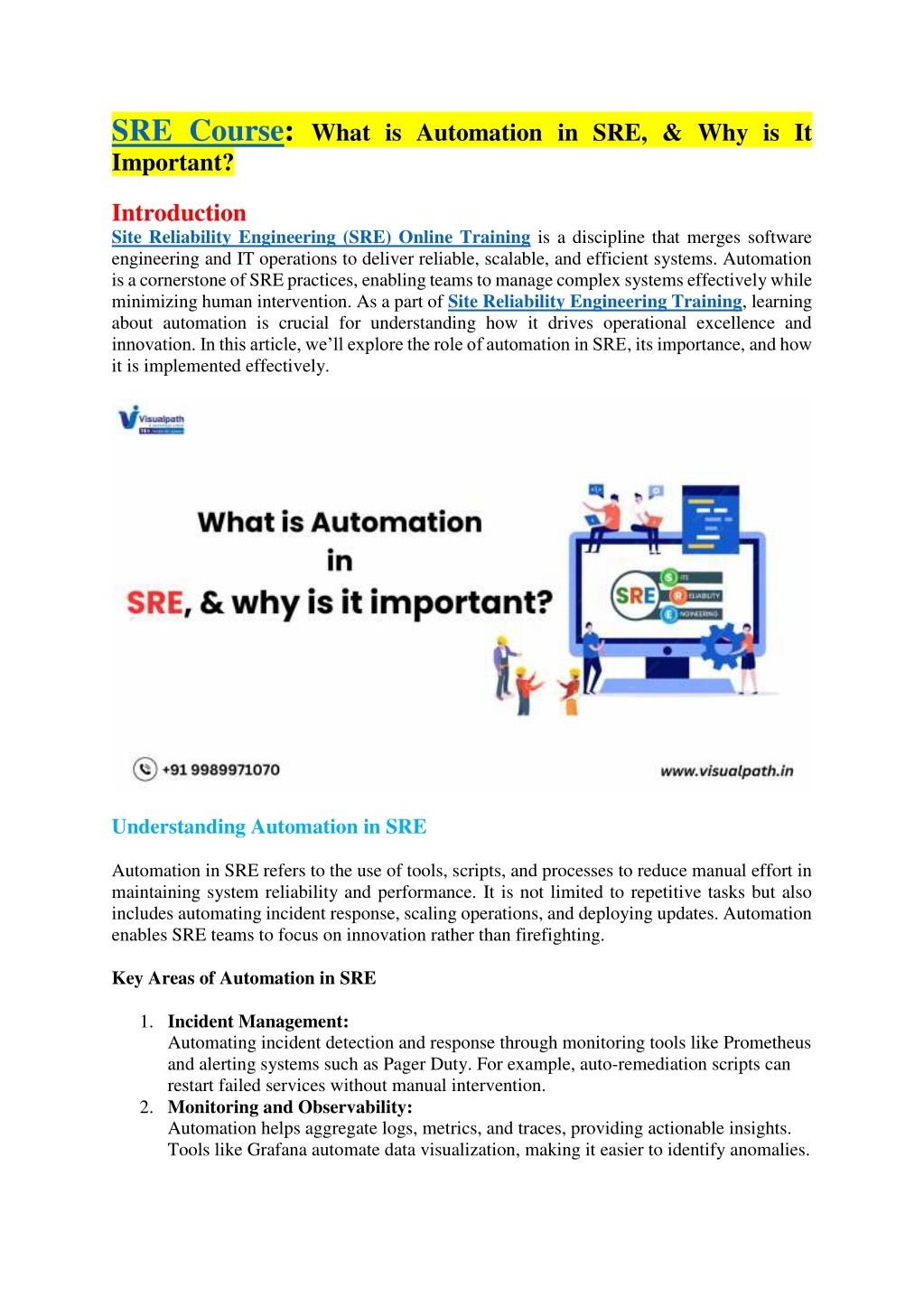
SRE Courses - SRE Training Online
Visualpath offers expert-led Site Reliability Engineering (SRE) Training with hands-on projects and real-world scenarios to boost your SRE career. The globally accessible SRE Course includes tools like Prometheus, Grafana, Datadog, ELK Stack, Ansible
Uploaded on | 1 Views
Download Presentation

Please find below an Image/Link to download the presentation.
The content on the website is provided AS IS for your information and personal use only. It may not be sold, licensed, or shared on other websites without obtaining consent from the author. Download presentation by click this link. If you encounter any issues during the download, it is possible that the publisher has removed the file from their server.
E N D
Presentation Transcript
SRE Course: What is Automation in SRE, & Why is It Important? Introduction Site Reliability Engineering (SRE) Online Training is a discipline that merges software engineering and IT operations to deliver reliable, scalable, and efficient systems. Automation is a cornerstone of SRE practices, enabling teams to manage complex systems effectively while minimizing human intervention. As a part of Site Reliability Engineering Training, learning about automation is crucial for understanding how it drives operational excellence and innovation. In this article, we ll explore the role of automation in SRE, its importance, and how it is implemented effectively. Understanding Automation in SRE Automation in SRE refers to the use of tools, scripts, and processes to reduce manual effort in maintaining system reliability and performance. It is not limited to repetitive tasks but also includes automating incident response, scaling operations, and deploying updates. Automation enables SRE teams to focus on innovation rather than firefighting. Key Areas of Automation in SRE 1.Incident Management: Automating incident detection and response through monitoring tools like Prometheus and alerting systems such as Pager Duty. For example, auto-remediation scripts can restart failed services without manual intervention. 2.Monitoring and Observability: Automation helps aggregate logs, metrics, and traces, providing actionable insights. Tools like Grafana automate data visualization, making it easier to identify anomalies.
3.Infrastructure as Code (IaC): Automating the provisioning of infrastructure using tools like Terraform and Ansible ensures consistency and reduces the risk of human error. 4.Continuous Integration and Continuous Deployment (CI/CD): Automation streamlines code deployment pipelines, ensuring rapid and error-free software delivery. Jenkins, Git Lab CI, and Azure DevOps are popular tools for this purpose. 5.Scaling Operations: Auto-scaling mechanisms dynamically adjust resources based on demand, optimizing performance and cost-efficiency. Why Automation is Important in SRE 1. Enhanced Reliability Automation reduces the probability of human error, a major cause of system downtime. Automated systems are consistent, ensuring high availability and reliability. 2. Faster Incident Resolution By automating alert prioritization and remediation processes, SRE teams can resolve incidents faster, reducing Mean Time to Recovery (MTTR). 3. Increased Productivity Automation frees up SRE teams to focus on strategic initiatives, such as improving system architecture or implementing new features, rather than managing day-to-day operations. 4. Scalability Manual processes often fail under large-scale operations. Automation enables systems to scale seamlessly by adapting to increased workloads. 5. Cost Efficiency Through auto-scaling and optimized resource allocation, automation reduces unnecessary expenses, ensuring efficient utilization of resources. 6. Improved User Experience With fewer outages and faster resolution times, automation contributes to a seamless user experience, boosting customer satisfaction and trust. Key Tools and Technologies for Automation in SRE 1. Monitoring and Alerting Prometheus: For metrics collection and monitoring. Nagios: For server monitoring and incident response.
2. Deployment Automation Jenkins: A CI/CD tool for automating builds and deployments. Spinnaker: Enables multi-cloud continuous delivery. 3. Infrastructure Automation Terraform: Manages infrastructure as code for consistent deployments. Chef and Puppet: Automates infrastructure configuration. 4. Log Aggregation ELK Stack (Elastic search, Log stash, and Kibana): For log analysis and visualization. Splunk: Provides insights from machine data. 5. Collaboration Tools Slack and Microsoft Teams: Integrates incident notifications for real-time collaboration. 6. Automation Frameworks Ansible: Simplifies configuration management. Kubernetes: Automates container orchestration, scaling, and maintenance. How to Implement Automation in SRE? 1. Identify Repetitive Tasks Begin by identifying tasks that are repetitive and time-consuming, such as log aggregation, backup processes, and performance monitoring. 2. Select the Right Tools Choose automation tools that align with your team s skill set and system architecture. Training through an SRE Course or Site Reliability Engineering Online Training can help in mastering these tools. 3. Build a Reliable CI/CD Pipeline Establish robust CI/CD pipelines to automate testing and deployment processes, ensuring smooth integration of new features without compromising reliability. 4. Monitor Automation Outcomes Continuous monitoring and improvement of automated processes are essential to ensure they remain effective as systems evolve. 5. Upskill Teams in Automation
Investing in an SRE Certification Course equips teams with the knowledge to leverage automation tools effectively, ensuring smooth implementation. Challenges in Automation for SRE 1. Initial Setup Complexity The implementation of automation tools can be time-consuming and complex, requiring skilled professionals. 2. Maintenance Overhead Automated systems require ongoing updates to align with changing system requirements and technologies. 3. Resistance to Change Teams may initially resist automation due to fear of job displacement or the steep learning curve involved in adopting new tools. Benefits of Learning Automation through SRE Training Enrolling in Site Reliability Engineering Training equips professionals with the skills to implement and manage automation effectively. Courses like the SRE Course and SRE Certification Course offer in-depth knowledge of tools and techniques, ensuring successful automation strategies. These training programs often include hands-on projects, enabling learners to implement real- world automation scenarios. With Site Reliability Engineering Online Training, professionals can gain the flexibility to learn at their own pace while mastering advanced automation techniques. Conclusion: The Role of Automation in SRE Training Automation is indispensable in Site Reliability Engineering, driving reliability, scalability, and efficiency. It transforms reactive operations into proactive, scalable solutions, aligning with SRE s goal of creating self-healing systems. By mastering automation through structured learning paths like Site Reliability Engineering Training, professionals can unlock the full potential of SRE practices. Programs such as the SRE Course, SRE Certification Course, and Site Reliability Engineering Online Training provide the foundation for building resilient systems. Investing in automation is not just about reducing workloads it s about enabling innovation and ensuring that systems remain reliable and efficient in the face of growing complexities. As organizations continue to prioritize reliability, the role of automation in SRE will only grow, making it an essential skill for every SRE professional.
Visualpath is the Best Software Online Training Institute in Hyderabad. Avail complete Site Reliability Engineering (SRE)worldwide. You will get the best course at an affordable cost. Attend Free Demo Call on - +91-9989971070. WhatsApp: https://www.whatsapp.com/catalog/919989971070/ Visit:https://www.visualpath.in/online-site-reliability-engineering-training.html






